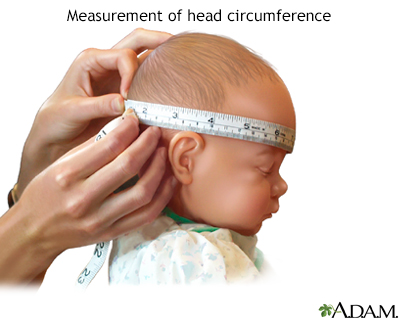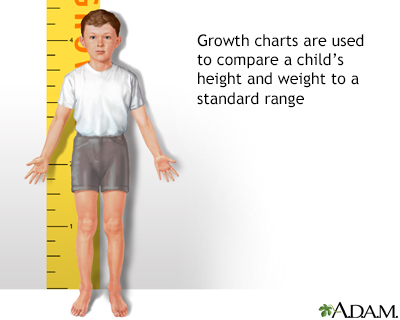Growth chart
Height and weight chart
Images


Information
Growth charts are used to compare your child's height, weight, and head size to children of the same age.
Growth charts can help both you and your health care provider follow your child as they grow. These charts may provide an early warning that your child has a medical problem.
Growth charts were developed from information gained by measuring and weighing thousands of children. From these numbers, the national average weight and height for each age and sex were established.
The lines or curves on growth charts tell how many other children in the United States weigh a certain amount at a certain age. For example, the weight on the 50th percentile line means that one half of the children in the United States weigh more than that number and one half of the children weigh less.
WHAT GROWTH CHARTS MEASURE
Your child's provider will measure the following during each well-child visit:
- Weight (measured in ounces and pounds, or grams and kilograms)
- Height (measured while lying down in children under age 3, and while standing up in children age 3 and older)
- Head circumference, a measurement of the head size taken by wrapping a measuring tape around the back of the head above the eyebrows
Beginning at age 2, a child's body mass index (BMI) can be calculated. Height and weight are used to figure out the BMI. A BMI measurement can estimate a child's body fat.
Each of your child's measurements is placed on the growth chart. These measurements are then compared with the standard (normal) range for children of the same sex and age. The same chart will be used as your child grows older.
HOW TO UNDERSTAND A GROWTH CHART
Many parents worry if they learn that their child's height, weight, or head size is smaller than those of most other children the same age. They worry about whether their child will do well in school, or be able to keep up in sports.
Learning a few important facts can make it easier for parents to understand what different measurements mean:
- Mistakes in measurement can happen, for example if the baby squirms on the scale.
- One measurement may not represent the big picture. For example, a toddler may lose weight after a bout of diarrhea, but will likely regain the weight after the illness is gone.
- There is a wide range for what is considered normal. Just because your child is in the 15th percentile for weight (meaning 85 out of 100 children weigh more), this number rarely means your child is sick, you are not feeding your child enough, or your breast milk is not enough for your baby.
- Your child's measurements do not predict whether they will be tall, short, fat, or skinny as an adult.
Some changes to your child's growth chart may worry your provider more than others:
- When one of your child's measurements stays below the 10th percentile or above the 90th percentile for their age.
- If the head is growing too slowly or too quickly when measured over time.
- When your child's measurement does not stay close to one line on the graph. For example, a provider may worry if a 6-month-old was in the 75th percentile, but then moved to the 25th percentile at 9 months, and dropped even lower at 12 months.
Abnormal growth on the growth charts is only a sign of a possible problem. Your provider will determine whether it is an actual medical problem, or whether your child's growth just needs to be watched carefully.
There are alternative growth charts for children with medical conditions such as Down syndrome or Turner syndrome. Using these specific charts may depict normal growth patterns of children with these conditions that affect weight and height.
References
Bamba V, Kelly A. Assessment of growth. In: Kliegman RM, St. Geme JW, Blum NJ, et al, eds. Nelson Textbook of Pediatrics. 22nd ed. Philadelphia, PA: Elsevier; 2025:chap 27.
Centers for Disease Control and Prevention website. National Center for Health Statistics. CDC growth charts. www.cdc.gov/growthcharts/cdc-growth-charts.htm. Updated September 2, 2024. Accessed December 23, 2024.
Centers for Disease Control and Prevention website. Birth defects. Growth charts for children with Down syndrome. www.cdc.gov/birth-defects/hcp/down-syndrome-growth-charts/index.html. Updated November 19, 2024. Accessed December 23, 2024.
DiVall SA, Radovick S. Normal and aberrant growth in children. In: Melmed S, Auchus RJ, Goldfine AB, Rosen CJ, Kopp PA, eds. Williams Textbook of Endocrinology. 15th ed. Philadelphia, PA: Elsevier; 2025:chap 22.
Hopkins AC Nutrition and growth. In: Anderson CC, Kapoor S, Mark TE, eds. Harriet Lane Handbook, The. 23rd ed. Philadelphia, PA: Elsevier; 2024:chap 21.
BACK TO TOPReview Date: 1/1/2025
Reviewed By: Charles I. Schwartz, MD, FAAP, Clinical Assistant Professor of Pediatrics, Perelman School of Medicine at the University of Pennsylvania, General Pediatrician at PennCare for Kids, Phoenixville, PA. Also reviewed by David C. Dugdale, MD, Medical Director, Brenda Conaway, Editorial Director, and the A.D.A.M. Editorial team. Editorial update 02/05/2025.

Health Content Provider
06/01/2025
|
A.D.A.M., Inc. is accredited by URAC, for Health Content Provider (www.urac.org). URAC's accreditation program is an independent audit to verify that A.D.A.M. follows rigorous standards of quality and accountability. A.D.A.M. is among the first to achieve this important distinction for online health information and services. Learn more about A.D.A.M.'s editorial policy, editorial process and privacy policy. A.D.A.M. is also a founding member of Hi-Ethics. This site complied with the HONcode standard for trustworthy health information from 1995 to 2022, after which HON (Health On the Net, a not-for-profit organization that promoted transparent and reliable health information online) was discontinued. |
The information provided herein should not be used during any medical emergency or for the diagnosis or treatment of any medical condition. A licensed medical professional should be consulted for diagnosis and treatment of any and all medical conditions. Links to other sites are provided for information only -- they do not constitute endorsements of those other sites. © 1997- 2025 A.D.A.M., a business unit of Ebix, Inc. Any duplication or distribution of the information contained herein is strictly prohibited.
